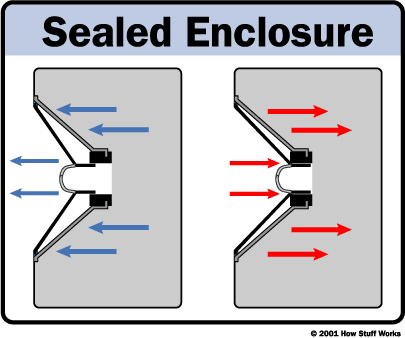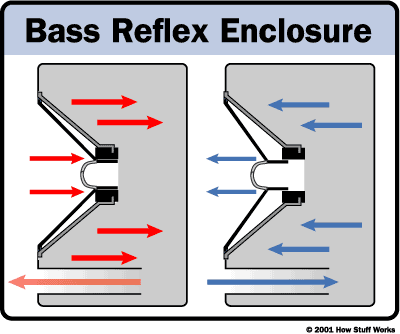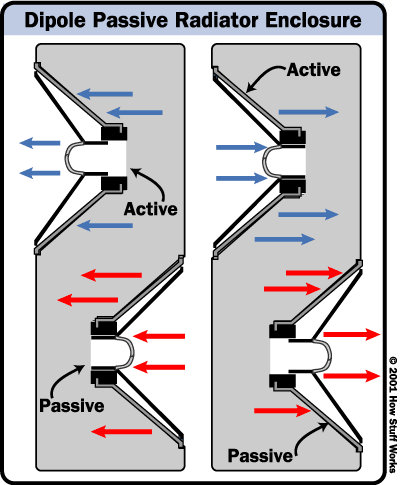
In most loudspeaker systems, the drivers and the crossover are housed in some sort of speaker enclosure. These enclosures serve a number of functions. On their most basic level, they make it much easier to set up the speakers. Everything's in one unit and the drivers are kept in the right position, so they work together to produce the best sound. Enclosures are usually built with heavy wood or another solid material that will effectively absorb the driver's vibration. If you simply placed a driver on a table, the table would vibrate so much it would drown out a lot of the speaker's sound.
Additionally, the speaker enclosure affects how sound is produced. When we looked at speaker drivers, we focused on how the vibrating diaphragm emitted sound waves in front of the cone. But, since the diaphragm is moving back and forth, it's actually producing sound waves behind the cone as well. Different enclosure types have different ways of handling these "backward" waves.
The most common type of enclosure is the sealed enclosure, also called acoustic suspension enclosure. These enclosures are completely sealed, so no air can escape. This means the forward wave travels outward into the room, while the backward wave travels only into the box. Of course, since no air can escape, the internal air pressure is constantly changing -- when the driver moves in, the pressure is increased and when the driver moves out, it is decreased. Both movements create pressure differences between the air inside the box and the air outside the box. The air will always move to equalize pressure levels, so the driver is constantly being pushed toward its "resting" state -- the position at which internal and external air pressure are the same.
These enclosures are less efficient than other designs because the amplifier has to boost the electrical signal to overcome the force of air pressure. The force serves a valuable function, however -- it acts like a spring to keep the driver in the right position. This makes for tighter, more precise sound production.
Other Speaker Enclosures


Other enclosure designs redirect the inward pressure outward, using it to supplement the forward sound wave. The most common way to do this is to build a small port into the speaker. In these bass reflex speakers, the backward motion of the diaphragm pushes sound waves out of the port, boosting the overall sound level. The main advantage of bass reflex enclosures is efficiency. The power moving the driver is used to emit two sound waves rather than one. The disadvantage is that there is no air pressure difference to spring the driver back into place, so the sound production is not as precise.
Passive radiator enclosures are very similar to bass reflex units, but in passive radiator enclosures, the backward wave moves an additional, passive driver, instead of escaping out of the port. The passive driver is just like the main, active drivers except it doesn't have an electromagnet voice coil, and it isn't connected to the amplifier. It is moved only by the sound waves coming from the active drivers. This type of enclosure is more efficient than sealed designs and more precise than bass reflex models.
Some enclosure designs have an active driver facing one way and a passive driver facing the other way. This dipole design diffuses the sound in all directions, making it a good choice for the rear channels in a home theater system.
These are just a few of the many enclosure types available. There are a huge range of speaker units on the market, with a variety of unique structures and driver arrangements.


